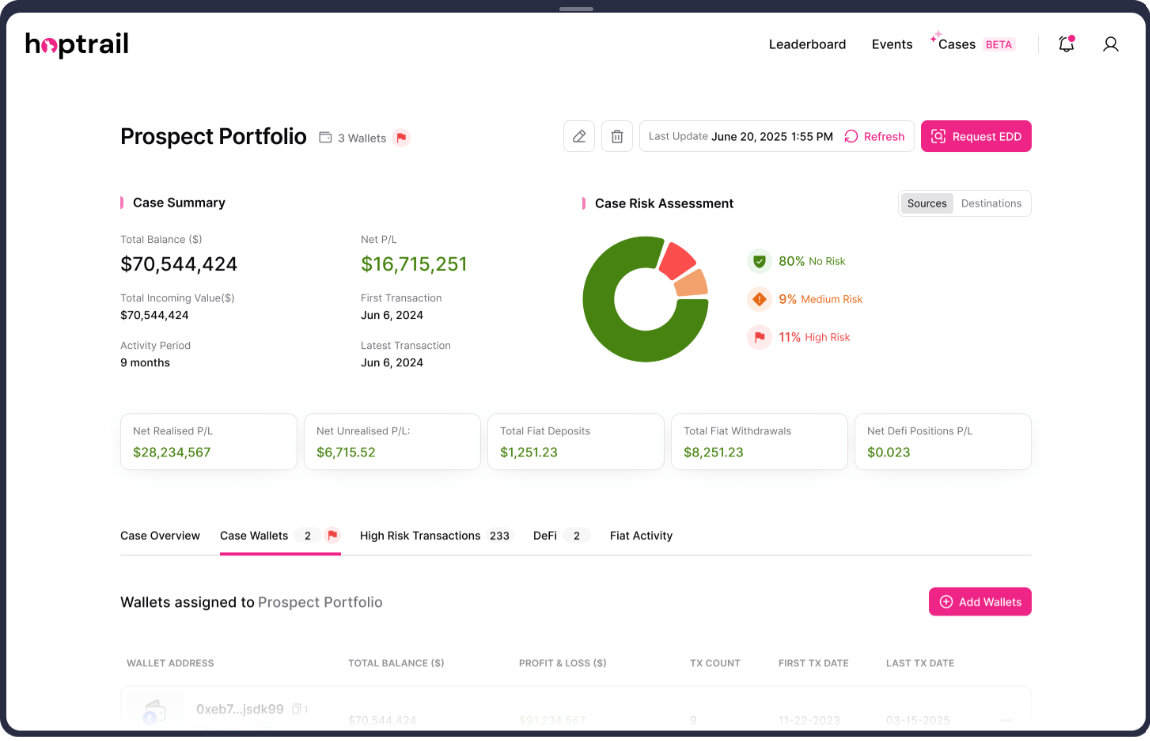The crypto onboarding kit: on-chain AML checks and client checklists

In the 12 months to December 2022, the number of people in the UK who own crypto doubled to just under 10% of the adult population.
This means that in coming years financial services and law firms will increasingly engage with clients who have interacted with or generated wealth in cryptocurrencies.
The first port of call with almost any client in those situations is AML checks. This will include standard KYC, including PEP and sanctions checks. But where firms are onboarding assets, additional checks need to be made around the source of those funds.
In most cases, this means evidencing how the client generated those funds - for example, inheritance, salary, bonuses, the sale of a house - and ensuring, where possible, the funds are not the proceeds of crime.
But how do we do that in crypto? Isn’t it anonymous?
Cryptocurrencies are pseudonymous. For example, every Bitcoin transaction that has ever been executed is publicly viewable online, for free. But the names of the people or entities undertaking those transactions are not disclosed. What you’ll see is the public addresses - a series of alphanumeric characters - sending and receiving funds.
Here’s an example we chose at random from blockchain.com, a Bitcoin block explorer. It shows one address sending BTC 0.1097 ($3,166) to another addresses. The second recipient is the same sender receiving change ($1.36) from the transaction.

This means that if someone provides you with their address, you can go online and see every single transaction they’ve ever done - the timestamps, the amounts, the values, and the counterparty addresses.
If you have enough data about who controls those other addresses, you can construct a complete map of their transaction history and start to run AML checks.
Using blockchain data to run source of funds analysis
That is where Hoptrail comes in. Hoptrail’s databases contain more than 250 million tagged addresses - from exchange venues, payment services and NFT marketplaces to darknet shops, mixing services and addresses tied to hacks, scams and sanctions.
Our database allows us to undertake detailed and thorough source of funds checks on counterparty wallets, and examine their potential exposure to financial crime risks.
Imagine the sender above was your client’s address. We can use Hoptrail’s tools to verify their source of funds.
This is what we see when we screen the address: all funds are coming from Binance, a cryptocurrency exchange.

The next step would be to ask the client for their Binance trading statement to check GBP or USD deposits to Binance. This is called the ‘on-ramp’ data - essentially the starting point for any source of wealth checks.
Once you have that you can roll forward and follow the money, all the way to the cash out. Below is an example of an address sending funds to exchanges they use to cash out into fiat currency.

We can see this address is depositing funds to three exchanges: Kraken, Binance, and Huobi - with some of those destinations identified as direct counterparties (1 hop) and some as indirect counterparties (2+ hops).
In this case, the client was using Binance and Kraken to liquidate funds. We would therefore need trading statements for these exchanges to evidence the BTC deposits and sales to GBP. That would be the next and final step in assessing a client’s on-chain activity - what we call ‘off-ramp’ activity.
Its important to remember that every crypto portfolio tells a story. They all have a beginning and an end, and so identifying these on- and off-ramps allows Hoptrail to be deployed to fill in the crucial trading and AML gaps in the middle.
What goes into the onbaording checklist?
Hoptrail’s onboarding checklist has three core requirements for source of funds and source of wealth checks. Ensure to ask each crypto client for these things before starting any analysis.

Do you need to verify wallet ownership?
If you suspect wallets provided by your client are not theirs, you can ask them to prove ownership. There are many ways of doing this. You may ask the client to transmit a specific amount to a designated wallet, or you could ask for further documentation from the service or exchange tied to the address.
Non-custodial services such as Ledger, Bitcoin Core, and Electrum have features which allow users to cryptographically sign a transaction to prove ownership that wallet. Likewise, for Ethereum, Etherscan provides a free, publicly available signature verification tool that allows public or private cryptographic proofs.

Crypto HNWIs: who they are and how they made their wealth

Cases: new source of wealth capabilities and upcoming features

Why we built Cases: A personal note on solving the crypto source of wealth headache
Subscribe to the Hoptrail newsletter
Sign up with your email address to get the latest insights from our crypto experts.
